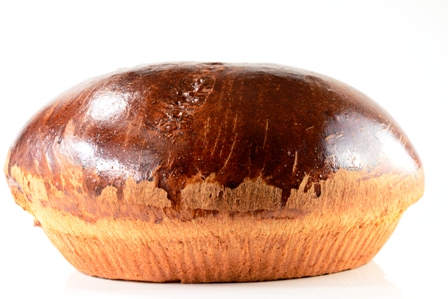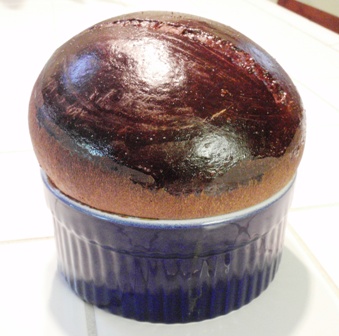Portuguese | Portuguese Sweet Bread
Revised on March 24, 2014
I love sweet bread and wanted to learn how to make it. I went looking for a recipe, and mostly found recipes that called for 20 cups of flour and made several loaves. That was probably good for my grandmother's generation where they had to feed families of 14, but for me, I just need one loaf. For my first attempt I used a recipe from Leite's The New Portuguese Table cookbook. The lemon zest and cinnamon give it something extra. I like the shape of the loaf and find it interesting that it is baked in a soufflé dish. I did find that it took awhile to cook the center and the crust ends up fairly thick. It was tasty though. * Update: I made this again. This time I baked the bread in a foil pie pan like my grandmother did. I liked it better that the soufflé dish version, the crust was softer.
Yield: 1 9-inch round loaf
Ingredients
1/2 cup whole milk
4 tablespoons unsalted butter, plus more for greasing
2/3 cup plus 1 teaspoon sugar
3/4 teaspoon kosher salt
1 package active dry yeast
2 tablespoons warm water (110° F)
3 large eggs
1 large egg yolk
4 cups unbleached all-purpose flour, plus more if needed
1/4 teaspoon ground cinnamon
grated zest of 1/2 small lemon
Method
Heat the milk, butter, the 2/3 cup of sugar, and the salt in a medium saucepan over medium-high heat, stirring frequently, just until steam begins to curl up and bubbles form around the edges, about 5 minutes. Set aside to cool to lukewarm.
Meanwhile, dissolve the yeast and the remaining 1 teaspoon of sugar in the warm water in a small bowl, and let sit until the liquid is foamy, about 10 minutes.
Plop 2 of the eggs and the yolk into the bowl of a stand mixer fitted with the paddle attachment, and beat until frothy and light, about 1 minute. With the mixer on low, slowly pour in the milk-butter mixture. Switch to the dough hook, dump in the flour, cinnamon, and zest, and pour in the yeast mixture. Mix on medium-low until the dough is supple, 8 to 10 minutes, scraping down the dough hook and the bowl and adding more flour if needed.
Turn the dough out onto a lightly floured work surface and shape into a ball. Place it in a large lightly buttered bowl, cover with plastic wrap, and let rise in a warm, draft-free spot until doubled in size, about 2 hours.
Generously butter a 1 1/2 quart round baking dish (6 1/2 inches in diameter, 3 inches high). Set aside. Punch down the dough, knead several times, and form it into a ball. Cup the ball in both hands and stretch the sides of the dough down and under, making an oval, then turn 90 degrees and repeat, creating a smooth round with a tight surface. Securely pinch the seams closed underneath, and place seam side down in the baking dish. Let rise, covered with a tea towel, in a warm, draft-free spot until doubled in size and well domed, 2 to 3 hours.
Position a rack in the lower third of the oven (remove any racks above to give the bread head room) and crank up the heat to 350° F.
With a very sharp knife, make a shallow slash across the top of the loaf. Beat the remaining egg and brush it generously over the top. Bake until the bread is a deep mahogany and an instant-read thermometer inserted in the middle registers 190 degrees F, 40 to 50 minutes. Watch closely; overbaking will cause the loaf to be dry. For a shiny crust, brush on more of the beaten egg about 15 minutes before the bread is done. Transfer to a rack to cool for 20 minutes. Remove the bread from the dish, and let cool completely. The loaf will last 2 to 3 days wrapped well in plastic.
(Ref. "Sweet Bread" recipe, The New Portuguese Table, page 199.)



